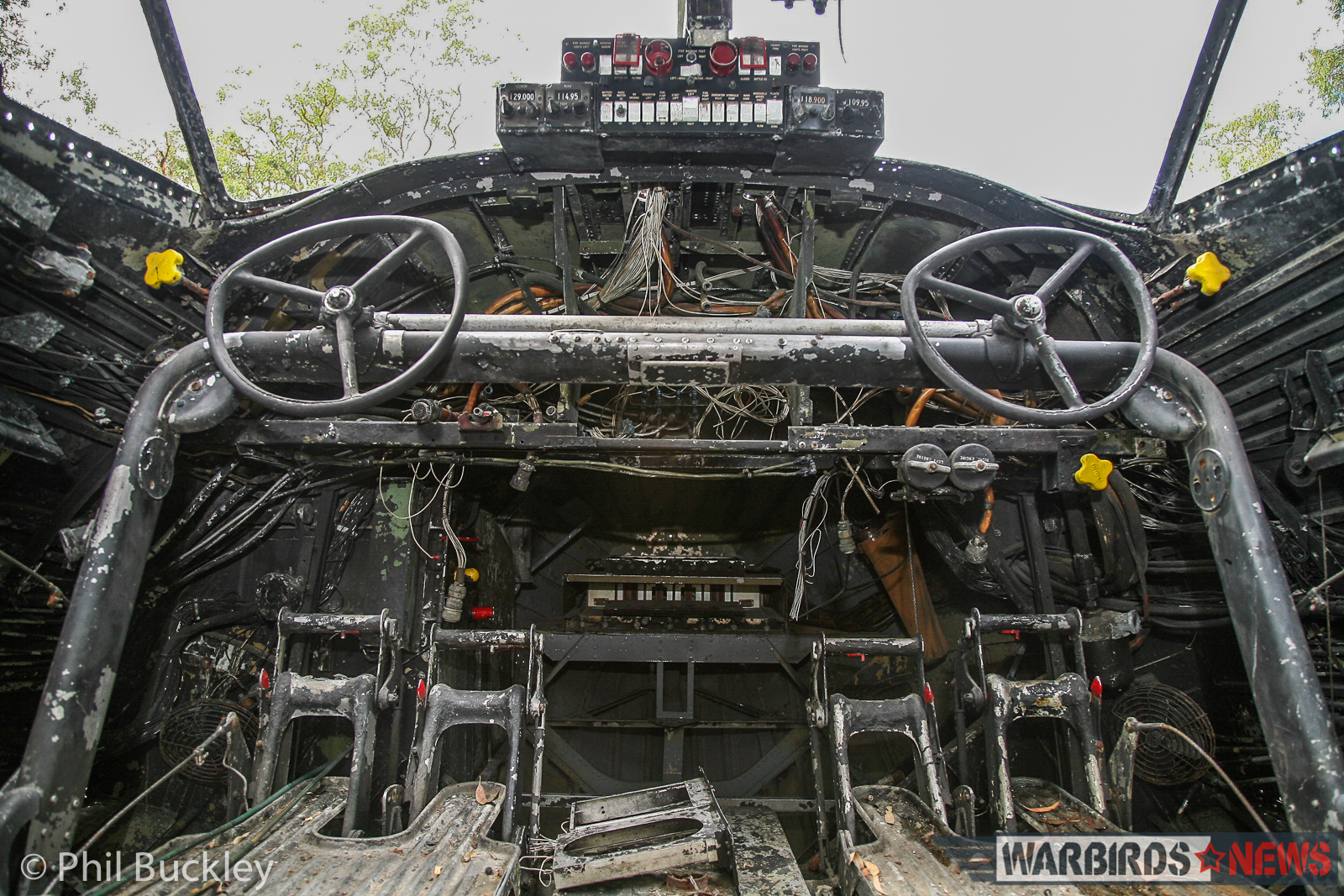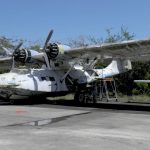A couple of years ago, our intrepid Antipodean reporter, Phil Buckley, wrote a story for us about a dedicated team restoring a tired and weatherbeaten PBY Catalina in Rathmines, Australia. Rathmines Park, nestled beside Lake Macquarie in New South Wales was once home to the largest RAAF flying boat base. As such, the local community wished to commemorate their storied past, with an appropriate aircraft at the focal point of their efforts. And thus they formed the Rathmines Catalina Memorial Park Association (RCMPA). In 2013, they found PBY-5A Catalina Bu.48412 on the auction site e-Bay of all places. The aircraft had been rotting away outside for the best part of two decades at San Juan International airport in Puerto Rico. Just getting the hulk to Australia was a massive undertaking, but the team has worked miracles on a shoestring budget (please see Phil Buckley’s previous report). They have saved this Catalina from almost certain scrapping, and made considerable progress since she arrived. We thought our readers would be interested to see what they have been up to since WarbirdsNews’ last visit.
PROGRESS TO DATE – 2016 AND PEOPLE BEHIND THE CATALINA
by Phil Buckley with John Richard
Down besides the shores of Lake Macquarie, RCMPA Project Co-ordinator, Mr.Terry Woolard, oversees the volunteer team with other members – Kerry, David, Michael, Peter, Rob, Brian, Andrew, Warren, Ray, and Peter. The youngest volunteer is 60years of age and oldest is in their 80s. As of April 2016, the volunteer team is making progress across the whole aircraft, bringing a radical change from the condition in which it arrived into the warbird it has become. At the current time, the project’s aims are to ensure the Catalina is fully inspected; that all corrosion is removed as best as possible; to repaint the airframe externally. In the longer term, they want to work on upgrading the internal fuselage with fit outs and restored items to WWII standard. As a team, they have made great advances.
CATALINA RESTORATION STATUS
Since arriving, the PBY has rested on a steel beam cradle. In 2016, the team added to this setup by welding on beams to widen the base. They have added vertical beams which incorporate an access walkway and support frames to erect a shade cloth over the fuselage, providing protection from sun, rain and wind for the restoration team. Nova Timber, a local timber company, has supplied all the timber needed for the walkway area which will enable better fuselage restoration access and other work to be undertaken.
FUSELAGE
The restoration team has bead-blasted, repaired and primed the Catalina’s hull. Many lower sections of the hull required replacing due to corrosion. The rear, right-hand side of the fuselage has had extensive re-sheeting of corroded skin and patch repairs. The front right nose panel has also received attention, and will eventually re-acquire the bomb aimer and nose turret positions of wartime Catalinas. The cockpit instrument panel has been removed, stripped and will be restored. The cockpit canopy framing has also been removed and is under refurbishment. Unknown to many, the interior skins were originally lined with linseed oil-soaked cloth to act as corrosion barrier. A door hatch on the port side has been rebuilt but now swings forward instead of upwards for ease of access. Volunteers have put many hours of rebuild work into other hatches as well. They will clean up and internally rebuild the engineers position in wing tower too. The nose landing gear must be cleaned and then reattached. The main landing gear will receive similar treatment.
TAIL
Volunteers have removed corrosion from the tail’s leading edge. RAAF 11 Squadron personnel from RAAF Edinburgh, South Australia are working in their own time to overhaul the tail assembly, elevators and rudder.
WINGS
The wings are currently stored awaiting overhaul. The team sprayed them with fish oil to inhibit corrosion. The wings will require sheet metal work once restoration begins in this area. The fabric control surfaces will need cleaning, inspection and repairs where necessary. The restoration team will also pressure wash the wing interior structure, then inspect and ameliorate any issues. The wings will of course require new trailing edge fabric and paint following their structural refurbishment.
ENGINES
The starboard engine is with the RAAF in South Australia under overhaul as a cut-away display model. The port engine is with the team and has been restored to static display condition, but has the potential to reach operational status by the end of 2016. This engine will then become a ground running example used as a tourist attraction. It will need a set of shorter propeller blades for that purpose. The RCMPA is also on the lookout for two extra Pratt & Whitney R-1830s to mount back on the airframe, although they might consider using replicas if none are available economically. A high priority is finding the appropriate engine cowlings to fit back on the Catalina, as the originals did not come with the project.
PROPELLERS
Six propeller blades are now on site, including all of their logbooks. They are 1970-dated, Hamilton Standard paddle blades. A Sydney-based LAME recently checked them over and said that they could be overhauled and restored to airworthy, but at AU$10,000 RCMPA decided it was not worth the time and money for a static condition airframe. Meanwhile the blades will receive a coating of HCF-50 to prevent corrosion and remain in storage until needed.
GROWING LOCAL INTEREST TO SUPPORT THE CATALINA PROJECT AND RAAF LEGACY
The long term aim for the RCMPA is to build a suitable museum on the former RAAF base at Rathmines allowing visitors to see a static display Catalina flying boat alongside a museum exhibition covering the station’s history and its subsequent post war uses. Rathmines still has some of its original 200+ 1930-1940s era building preserved on site. Some of the buildings include the former Officers Mess (now the Rathmines Bowling Club), technical workshops (in use with a church group), the cinema/hall (now a community centre), the Sergeants mess (now a music centre). The local Sea Scouts unit is using another building on site. Local recreational fishermen use the hardstand and ramps to launch their boats at weekends, but they also serve in their original purpose when the Seaplane Pilots Association holds their fly in during the Rathmines Catalina Festival.
The Catalina festival is generating more and more interest for locals and aviation enthusiasts with the air show, heritage displays, stalls, seaplanes… it’s all making for an interesting day out for people to visit Rathmines. Each year the relatives of wartime service personnel tell more stories of their fathers or mothers experiences, or bring along items from their military service for display in the proposed museum. The big challenge that the RCMPA faces is the cost associated with building and running the museum. The proposed museum building will likely cost about AU$500,000 to plan, build and fit out. This hefty price will have to come from gifts, grants or in-kind donations from interested parties. The RCMPA hopes that State and Federal Governments might also contribute, as it will be a significant benefit to regional and national heritage, as well as a natural tourism draw.
LOOKING AHEAD – THE FUTURE
The future looks encouraging, but the RCMPA need assistance, donations and volunteers to help this tribute to Lake Macquarie’s WWII RAAF heritage achieve its goal. Sponsors are needed to help fund the proposed museum and the annual running costs. In addition, the RCMPA needs volunteers to help preserve the Rathmines Catalina. Anyone with sheet metal or structural repair skills are of particular interest, but all assistance will be gratefully accepted. A business plan is currently in place for the proposed museum, with a building development application in progress. Once the museum is built, it will help keep alive the rich history of Rathmines, the home base of the Catalina, as well as the people who flew and maintained the planes during the events of WWII. With more and more WWII heritage disappearing each year, it is essential that the Rathmines museum project be funded to preserve the memories of daring and sacrifice for the appreciation of generations to come.
Many thanks indeed to Phil Buckley for bringing us this report on the Rathmines Catalina!










































